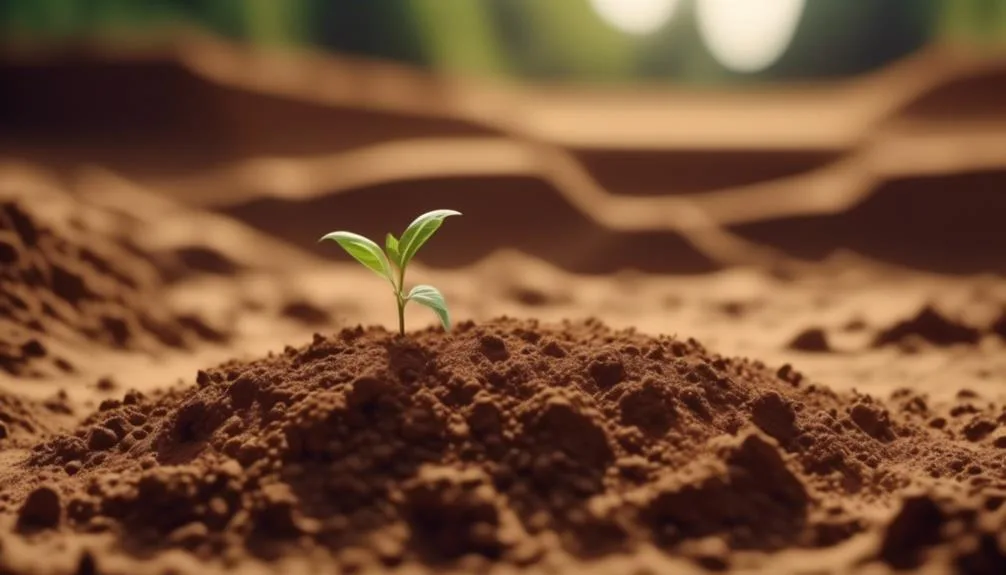For successful growth of beech trees, it's important to understand the right soil conditions. Factors like soil acidity, drainage, and nutrients impact their well-being.
But what exactly do beech trees need from the soil, and how can you ensure your soil meets these standards for optimal growth?
Let's explore the essential soil conditions for planting beech trees.
Soil Ph Requirements for Beech Trees
To ensure healthy growth, beech trees require a slightly acidic to neutral soil pH ranging from 6.0 to 7.5. This pH range provides the optimal conditions for beech trees to thrive. It's important to regularly test the soil pH and make any necessary adjustments to ensure it falls within this range.
Additionally, proper soil moisture is crucial for the successful growth of beech trees. Adequate moisture levels should be maintained, as beech trees prefer well-draining soil that's consistently moist but not waterlogged.
When planting beech trees, proper tree spacing is also essential. Adequate space between trees allows for optimal root development and prevents competition for resources. Aim to space beech trees at least 20-30 feet apart to provide ample room for their growth and development.
Optimal Soil Drainage for Beech Trees
Considering the crucial role of soil moisture in beech tree growth, achieving optimal soil drainage is essential for the healthy development of these trees.
Adequate water retention is vital, as beech trees thrive in well-drained soils that still retain moisture.
Soil compaction should be minimized, as compacted soil can impede drainage and lead to waterlogged conditions, which are detrimental to beech trees.
To ensure optimal soil drainage, incorporate organic matter such as compost into the soil to improve its structure and water-holding capacity.
Additionally, consider planting beech trees in raised beds or mounds to promote better drainage.
Avoid overwatering, as excessive moisture can lead to root rot and other diseases.
Nutrient Needs for Beech Tree Growth
When cultivating beech trees, it is crucial to provide the necessary nutrients to support their vigorous growth and overall health. Beech trees have specific nutrient needs that are essential for their optimal development. Ensuring the right balance of nutrients is crucial for promoting robust root development and efficient nutrient uptake. Below is a table outlining the key nutrients required for beech tree growth:
| Nutrient | Function | Sources |
|---|---|---|
| Nitrogen | Essential for leaf and stem growth | Organic matter, fertilizers |
| Phosphorus | Aids in root development and flowering | Bone meal, rock phosphate |
| Potassium | Regulates water uptake and disease resistance | Wood ash, kelp meal |
Soil Texture Preferences for Beech Trees
For optimal growth and development, beech trees thrive in well-drained soils with a loamy texture that provides a balance of water retention and drainage.
Clayey soil, which retains moisture and nutrients well, can be too compact for beech tree roots, potentially hindering their development. On the other hand, sandy soil, while well-draining, may not provide sufficient moisture for the tree's needs.
The loamy texture, consisting of a balanced mixture of sand, silt, and clay, offers an ideal environment for beech trees. This texture allows for adequate moisture levels while preventing waterlogging, which can impede root development.
When planting beech trees, it's crucial to ensure that the soil texture is conducive to their growth, providing the necessary balance of moisture retention and drainage for healthy root development and overall vitality.
Best Soil Location for Planting Beech Trees
To ensure the optimal growth of beech trees, it's essential to identify the best soil location that maintains a balance of water retention and drainage, supporting healthy root development and overall vitality.
When choosing a location for planting beech trees, consider the tree spacing to allow for ample room for growth. Beech trees thrive in locations with partial to full sun exposure. Select a site that receives at least six hours of direct sunlight per day to promote healthy and vigorous growth.
Additionally, ensure the soil in the chosen location is well-draining to prevent waterlogging, which can lead to root rot. By providing the right amount of space between trees and ample sunlight, along with well-draining soil, you can create an ideal environment for beech trees to flourish.
Conclusion
To enhance your soil and support the growth of beech trees, there are several steps you can take.
First, prioritize soil with slightly acidic pH, good drainage, and ample nutrients. This will provide the optimal conditions for the trees to thrive.
Next, opt for loamy soil that is rich in organic matter. Loamy soil has a balanced texture of sand, silt, and clay, which allows for good drainage while still retaining enough moisture for the tree's roots. Organic matter, such as compost or well-rotted manure, should be added to enrich the soil and provide essential nutrients.
Additionally, provide partial shade for the beech trees. While they can tolerate some sunlight, too much direct sunlight can lead to stress and damage. Planting the trees in an area that receives dappled sunlight or providing some shade through the use of shade cloth or strategically placed structures can help create a more ideal environment for their growth.
By following these steps and creating the right soil conditions, you can ensure the thriving growth of beech trees and enjoy their magnificence for years to come.

My interest in trees started when I first saw the giant sequoias in Yosemite.
I was a teenager then, and I remember thinking, “I need to learn more about this.”
That moment stuck with me.
A few years later, I went on to study forestry at Michigan Tech.
Since graduating, I’ve worked in a mix of hands-on tree care and community education.
I’ve spent over ten years helping people understand how to plant, maintain, and protect the trees in their neighborhoods.
I don’t see trees as just part of the landscape.
They are living things that make a real difference in our daily lives.
